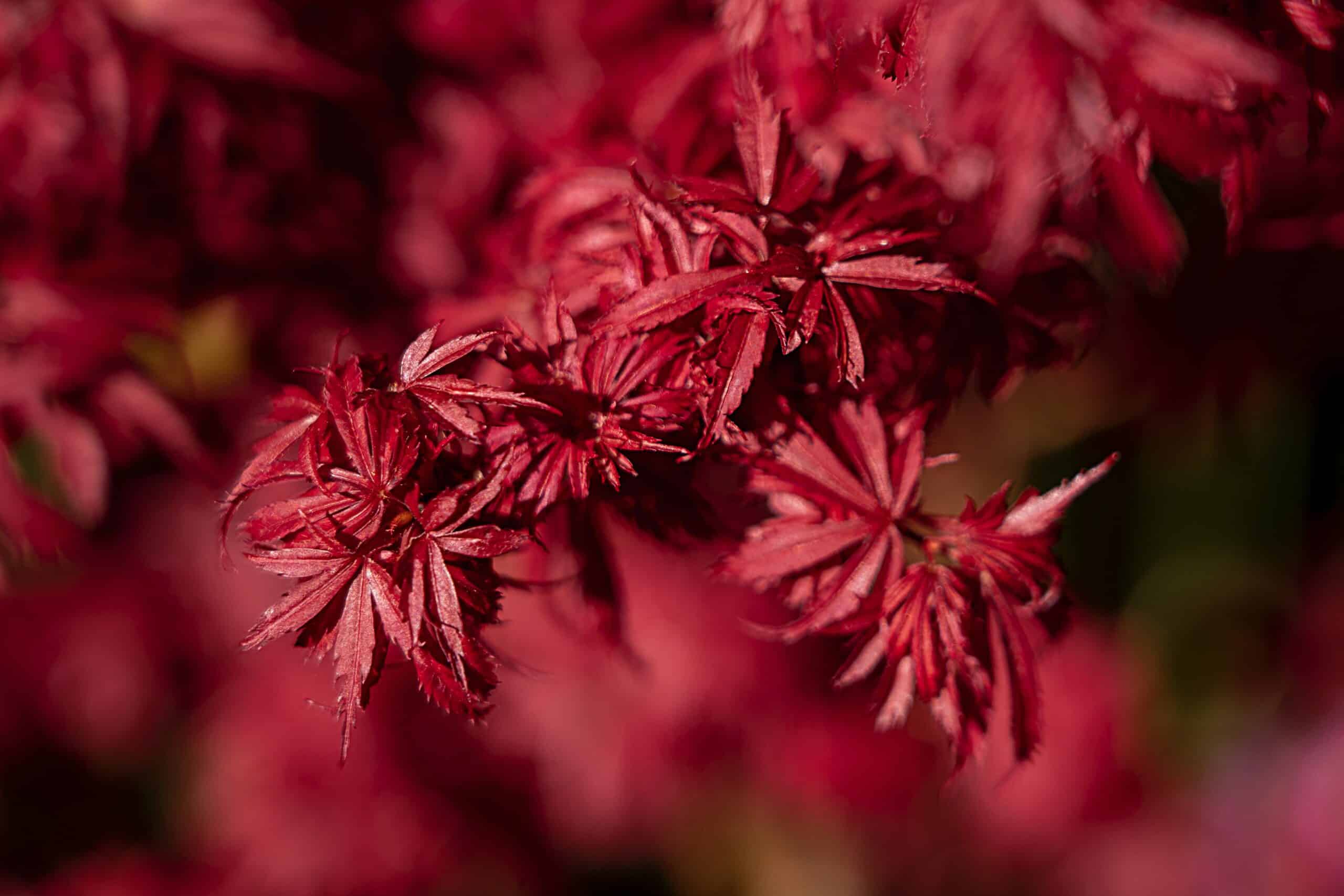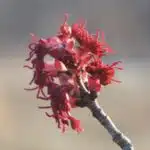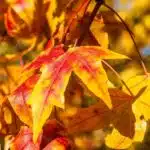When it comes to gardening, the old adage of ‘Know Your Enemy’ rings true. Amur maple (Acer ginnala) is a fast-growing and hardy deciduous shrub that can be found in many gardens across North America. While they are generally prized for their low maintenance needs and vibrant foliage, they can quickly become an invasive species if left unchecked. As such, it is important to identify and remove Amur Maple before it has a chance to spread and take over your garden. In this article, we will discuss how to identify and remove Amur Maple from your garden in order to keep your plants healthy and thriving for years to come.
Amur Maple is an attractive plant with pointed green leaves that turn spectacular shades of yellow, orange, and red in autumn. It grows quickly into a medium-sized tree or shrub that can reach up to 15 feet tall. The bark of the plant is grayish-brown in color with branches that tend to droop down as the tree matures. One of its most distinguishing features are its clusters of small yellow flowers which bloom in springtime followed by winged samaras which contain the seeds for reproduction.
In addition to its attractive appearance, Amur Maple has some other characteristics which make it an undesirable guest in some gardens if not properly managed. For example, if left unchecked this plant can rapidly spread throughout an area due to its prolific seed production as well as its ability to sprout from dormant roots or even from cuttings taken from existing plants. Furthermore, these maples have shallow root systems which makes them difficult to control once established, as well as vulnerable when exposed to drought conditions or extreme temperatures.
In this article, we will provide all the information you need about identifying and removing Amur Maple so you can keep your garden free of this invasive species while still enjoying all the beauty it has to offer!
What Is Amur Maple?
Coincidence has it that the Amur Maple is one of the most adaptable trees in nature. It grows in almost any climate, withstanding harsh winters and dry summers alike. As a gardener, you may have noticed this hardy tree growing in your own backyard – its deep green leaves and red-orange fall foliage make it unmistakable.
But how can you identify an Amur Maple? This deciduous tree typically grows to about 20 feet tall, but its slender trunk often gives it an even taller appearance. Its leaves are opposite and simple, with three lobes at the base and two at the top. Its bark is smooth with a grayish-brown color – though it will darken over time. The fruits are small, winged samaras that turn yellow when ripe.
If you have an Amur Maple on your property that needs to be removed, hiring a professional tree service is recommended to ensure safety and proper removal. In some cases, herbicides can be used to treat the stump after removal; however, these should only be applied by certified professionals for best results.
Where Does Amur Maple Grow?
The Amur maple tree (Acer ginnala) is a native of East Asia, including Japan, China and Korea. It is an ornamental plant that can be grown as a small tree or large shrub. In fact, the Amur maple is one of the most widely planted trees in North America – over 3 million have been planted in parks and gardens across the continent!
This deciduous tree has a fast growth rate and matures to about 20 feet tall, with an equal spread. It’s known for its vibrant fall foliage, which turns shades of yellow, orange and red. However, it can also produce attractive spring flowers with red-pink wings.
The best climate for growing Amur maple trees is one with cold winters and warm summers. They prefer full sun but will tolerate partial shade as well. Although they do not need much water once established, they will benefit from regular watering during periods of drought or extreme heat. TIP: Prune your Amur Maple in late winter or early spring before new growth begins to ensure optimal health and shape.
How To Identify Amur Maple Trees
Amur maple trees are like helpful friends, often overlooked but always there when you need them. They have many unique characteristics and identifying them is key to helping them flourish. Botanists and gardeners alike can utilize the following tips to properly identify an amur maple tree.
First, it’s important to note that the Amur Maple is a deciduous tree and grows in a pyramidal shape – unlike its cousin, the box elder, which has opposite branching of leaves along its stem. The leaves of an Amur Maple are broad with serrated edges and they turn yellow in fall before shedding their leaves for winter. Its small red flowers bloom from April to May and develop into two-winged fruits called samaras by June. Its bark is thin, grayish-brown and may be slightly corky or scaly in texture.
In addition to these physical characteristics, it’s also important to consider where an Amur Maple will grow best. It prefers partial shade or full sun locations with average soil that drains well – swampy areas should be avoided as their roots won’t thrive in standing water. Amur Maples can tolerate dry periods better than most other species and are generally quite hardy when it comes to temperature extremes so they can be grown in USDA zones 4-8 with great success!
By taking into account these factors, botanists and gardeners can easily identify an Amur Maple tree while also ensuring it has all the requirements necessary for healthy growth!
Amur Maple Tree Growth Requirements
Amur maple trees aren’t just striking to look at, they’re also surprisingly versatile. As such, it’s no wonder that these beautiful trees are increasingly popular among gardeners. But what does it take to make sure your Amur maple grows healthily? Let’s explore the growth requirements of this majestic tree.
In order for an Amur maple to thrive, it needs plenty of sunlight and a protected location. They prefer full sun exposure as opposed to partial shade, although young saplings will benefit from some protection when first planted. Additionally, these trees need regular moisture and consistently moist soil in order to survive. Amur maples can tolerate both dry and wet soils but do best when kept moist throughout the growing season.
Finally, Amur maples need a slightly acidic soil with a pH between 5.5-6.5 in order to truly flourish. If you find that your soil isn’t quite acidic enough, adding fertilizer can help to bring down the pH level so that your tree will thrive in its new home! With the right conditions and care, an Amur maple can be a stunning addition to any garden or landscape – one that will provide years of beauty and enjoyment for all who witness its elegant beauty!
Amur Maple Tree Soil Preferences
Soil preferences for an Amur Maple tree are like a fingerprint – unique and specific to the individual tree. The soil must be of good quality, with ample drainage. It should also be fertile and non-invasive, providing nutrients to the tree without competing against it. As a Specialist in botany and gardening, I would recommend that the soil consist of equal parts loam, sand and peat moss for best results.
When planting an Amur Maple tree, it is important to use topsoil mixed with organic matter such as compost or aged manure. This will ensure that the soil has adequate nutrients to nourish the tree’s roots. Additionally, adding mulch around the base of the tree can help create a layer of insulation and prevent weeds from becoming established in its place.
The key to maintaining healthy Amur Maple trees is providing access to water without letting it become soggy or overly saturated. Too much water can cause root rot while too little can leave them vulnerable to drought stressors. A delicate balance must be achieved in order to give these trees their best chance at thriving in your garden environment. With careful attention to soil preferences and proper watering techniques, you can enjoy many years of beauty from your Amur Maple trees!
Amur Maple Tree Water Requirements
The Amur maple is a beautiful and resilient tree, with colorful leaves that change throughout the year. However, proper care must be taken to ensure its growth and long-term health. One of the most important factors to consider is water requirements. It’s essential to keep the soil moist without over watering or allowing it to dry out completely.
When deciding how much water your Amur maple needs, you should consider your local climate and soil conditions. In dry climates, you may need to provide more frequent irrigation than in wetter climates. The soil should be damp but not soggy; if it feels like a wrung out sponge when touched, then it has just the right amount of moisture for the tree’s roots. Additionally, mulching around the base of the tree can help retain moisture in the soil during hot weather.
Finally, pay attention to any signs that your Amur maple isn’t receiving enough water such as wilting or yellow leaves. If this happens, increase watering until your tree recovers and then adjust your regular schedule accordingly. With proper care and attention, this resilient tree can thrive in many different climates and soils. Now let’s look at what you need to know about fertilizing your Amur maple tree in order to give it the best chance of long-term success!
Amur Maple Tree Fertilizing Requirements
Amur maple trees are great additions to any landscape, but they do require some special care when it comes to fertilizing. Fertilizing is an important part of maintaining healthy amur maple trees and ensuring their long-term health. Knowing when and how much to fertilize is key.
The best time to fertilize your amur maple tree is in the spring, after any frost has passed and the soil has had a chance to warm up. It’s important to use a fertilizer specifically formulated for acid-loving plants like amur maples. This type of fertilizer will provide essential nutrients like nitrogen, phosphorus, and potassium that will help promote lush foliage growth during the growing season. Apply one pound of fertilizer per inch of trunk diameter around the base of the tree, making sure not to get the fertilizer too close to the trunk itself. Water the area after application, as this will help move the nutrients into the root system.
Fertilizing your amur maple tree once or twice a year is all that’s necessary for proper maintenance. Be careful not to overfertilize, as this can cause excessive growth which can lead to weak branches and stem breakage from heavy snow or ice loads in winter months. With proper fertilization and care, your amur maple tree should be healthy for years to come!
Amur Maple Tree Pruning And Maintenance
Amur maple trees require regular pruning and maintenance to ensure they look their best, while also keeping them healthy. Interestingly, according to research, the Amur maple is one of the most hardy and adaptable species of maple tree available. So, it’s important to consider how much pruning and maintenance is needed for a specific tree.
When it comes to pruning and maintenance for Amur maples, timing is key. Prune during mid-summer when new growth slows down or in late winter when the tree is dormant. Pruning helps maintain its shape and size by removing branches that are dead or diseased. If a branch needs removal due to an infestation of pests or disease, take care not to spread the infection further by sanitizing all tools used in the process. Additionally, if you’re looking to improve air circulation around the tree, trimming away any crowding between stems can help prevent disease from spreading.
For optimal health, fertilize your Amur maple with a balanced fertilizer at least once annually during early spring before buds open up. Make sure that fertilizer is applied evenly throughout the entire root zone of the tree; this will help ensure healthy growth throughout its lifespan. Proper watering practices are also essential for maintaining an Amur maple; water deeply every two weeks depending on weather conditions and soil type. By following these steps you can ensure that your Amur Maple remains in optimal health for many years to come!
Amur Maple Tree Disease And Pest Protection
Amur maple trees are a tough species, but they can be subject to disease and pest threat if adequate precautions are not taken. In fact, an estimated 80% of all tree deaths in the urban and suburban environment are caused by insects or pathogens. Fortunately, there are some effective measures that can be taken to protect these trees from disease and pests.
As with many plants, prevention is the best cure when it comes to safeguarding amur maples from disease and pests. Regular pruning and maintenance should be done at least once a year to ensure the health of the tree. Pruning should focus on removing dead or damaged branches, as well as thinning out any overcrowded areas. This will help promote better air circulation through the canopy, which can reduce the likelihood of fungal infection. Additionally, mulching around the tree can help suppress weed growth and keep the soil moist.
Finally, regular inspections should be conducted for signs of insect infestations or fungal diseases. If any symptoms are found, contact an arborist immediately for treatment advice as soon as possible. With proper preventative care, amur maple trees can thrive for decades with minimal disease and pest issues. By following these simple steps, homeowners can ensure their trees remain healthy for years to come.
How To Remove An Amur Maple Tree
Removing an Amur maple tree can be a challenging process, and it is important to understand the various methods involved. In this section, we will explore how to safely and effectively remove an Amur maple tree from its current location.
Firstly, it is essential to consider the size of the tree and the environment it is in. If the tree is small enough, manual removal may be possible with shovels and saws. However, for larger trees, more heavy-duty tools such as a chainsaw or power auger may be necessary. Additionally, if the area around the tree has obstacles such as fences or other plants that may get damaged during removal, then alternative methods must be considered.
When removing an Amur maple tree of any size, there are several steps to take: • Trim away any excess branches or foliage • Carefully dig around the roots of the tree • Cut through any major roots that remain in ground • Lift out of hole and discard appropriately
It is also important to take into account any possible effects on nearby trees when removing an Amur maple. The use of a stump grinder may be necessary if there are other trees nearby that could suffer root damage during the removal process. Additionally, debris should always be disposed of responsibly according to local regulations.
With these tips in mind, anyone can safely and efficiently remove an Amur maple from their landscape. By taking care when conducting this operation and properly disposing of debris afterward, one can ensure that their garden remains healthy for years to come. With our discussion now complete on how to remove an Amur maple tree, let us move on to exploring how best to propagate them for future generations.
Amur Maple Tree Propagation
Propagating an Amur maple tree is a great way to create a beautiful, natural landscape. Like any kind of propagation, it requires a bit of knowledge and patience. As the old saying goes: “Slow and steady wins the race!” Here’s how you can propagate an Amur maple tree yourself.
First, you’ll need to make sure that your new tree has access to plenty of sunlight. This type of tree prefers full sun for at least six hours each day during the growing season. If possible, try to pick an area with well-draining soil so that the roots don’t get too waterlogged.
Next, choose some healthy cuttings from existing trees in your garden or buy some starter material from a nursery or garden center. These should be about three feet long and have at least one bud on them – this will help ensure success when propagating them. Plant the cuttings in small pots filled with potting mix and water them regularly until they are established.
TIP: Before planting your cuttings, dip them in rooting hormone powder to speed up their root development. This will also help reduce any potential problems associated with propagating your Amur maple tree such as disease or pests.
Amur Maple Tree Uses
The Amur maple tree is a unique species of maple found primarily in the cold-weather regions of East Asia. It has long been prized for its beauty and hardiness, making it an ideal choice for landscaping and gardening projects. But there’s more to this tree than meets the eye – it has many uses that could prove useful to any gardener or homeowner. Let’s take a closer look at the varied and valuable uses of this versatile plant.
First, Amur maples are extremely resistant to harsh weather conditions, making them ideal for planting in areas that experience extreme temperatures throughout the year. In addition, their leaves are larger than other varieties of maple trees, giving them an attractive look that can add some visual appeal to any outdoor space. They also have a deep root system that helps to prevent soil erosion and provide stability during storms.
Another major benefit of Amur maples is their ability to tolerate wet soil conditions without becoming waterlogged or diseased. This makes them particularly useful for gardeners who live in areas with a high risk of flooding or heavy rainfalls. Furthermore, they can easily thrive in a wide range of light conditions – from full sun to partial shade – so they can be planted virtually anywhere in your yard or garden.
Finally, these trees are also very easy to propagate – meaning you can quickly grow new plants by harvesting seeds or cuttings from mature plants! With all these benefits, it’s no wonder why Amur maples are such a popular choice among gardeners and homeowners alike…
Amur Maple Tree Benefits
Amur maple trees (Acer ginnala) are highly beneficial for any garden. They are known for their showy fall colors and adaptability to a wide range of soil types. In addition, they are hardy in USDA zones 3-7, so they can be grown in most parts of the United States. Furthermore, an interesting statistic about Amur maple trees is that their bark has been used for centuries as a medicinal treatment for a variety of illnesses.
From a horticultural standpoint, it’s easy to appreciate the many benefits of Amur maple trees. For starters, they’re very easy to care for and require only minimal pruning and fertilizing. Plus, they boast beautiful foliage all season long and can be planted as either single specimens or grouped together to create an attractive landscape feature. Additionally, Amur maples provide welcome shade with their dense canopy of leaves during the hot summer months.
When it comes to identifying and removing Amur maples from your garden, look out for their distinctive three-lobed leaves which emerge bright green during spring and turn yellow or orange in fall. If you do decide to remove one from your garden, take extra care not to damage the roots when digging up the tree as these can suffer from transplant shock if handled improperly. With proper care and attention, Amur maples make an excellent addition to any home landscape!
Amur Maple Tree Drawbacks
It is almost as if our paths were meant to cross, as I am a specialist in botany and gardening and you are in search of information about the Amur Maple Tree. While this tree has its benefits, there are a few drawbacks that should be noted before deciding whether or not it is the right fit for your needs.
First and foremost, the Amur Maple Tree requires plenty of space in order to properly grow. It can reach heights of up to 25 feet tall with a spread of 30 feet wide. This could pose an issue for those who have smaller yards or gardens. Additionally, this tree thrives in full sun exposure but can also tolerate partial shade. However, it does require consistent watering throughout its growing season which may present another challenge for some gardeners.
Lastly, the branches of the Amur Maple Tree tend to droop significantly due to their heavy foliage. If planted too close to a home or other structure, they may cause damage over time due to their weight and size. Also, these trees are vulnerable to rust disease which can lead to defoliation if left untreated. For these reasons, it is important to take into account all aspects when considering planting an Amur Maple Tree in your garden or yard.
Given all the potential risks associated with planting an Amur Maple Tree, it is important to consider alternative options that could better suit your needs. The next step is researching what other plants would be more suitable for your desired space and climate conditions.
What To Plant In Place Of An Amur Maple Tree
Nature lovers may want to consider an Amur Maple tree for their garden, but the drawbacks should be taken into consideration. From its shallow root system to its susceptibility to diseases and pests, it is not always the best choice for a garden. But what can be planted in its place?
The possibilities are endless! With vibrant colors, unique shapes, and interesting textures, there is no shortage of plants that could take the place of an Amur Maple tree. As you walk through your garden, imagine lush foliage of different sizes and shapes. Take in the bright greens and deep purples that contrast with each other as they dance in the breeze. The beauty and diversity of flowering trees, shrubs, perennials, and even vegetables can provide a rewarding experience that will last throughout all four seasons.
Of course, it is important to consider what kind of environment you live in before planting any type of tree or shrub. Make sure you understand how much sunlight your garden gets each day so that you can choose plants that are suited for your area. Also think about how much maintenance will be needed for each plant – some require more attention than others. Once you have identified this information, you can begin selecting which species will make your garden come alive with beauty and life!
Frequently Asked Questions
What Is The Average Lifespan Of An Amur Maple Tree?
A mature Amur Maple tree is like a loyal friend – an ever-present companion that stands by you through thick and thin. Its average lifespan of 25-40 years allows it to be a steadfast symbol of permanence in the garden.
Botanists and gardeners alike pay special attention to the Amur Maple due to its ability to thrive in harsh conditions. This species can tolerate cold weather, light shade, and drought – making it a popular choice for those who want an easy-to-care-for tree. It grows fast, reaching heights of up to 30 feet with a rounded canopy spreading outwards from its trunk in all directions.
Identifying this species can be done by looking at its leaves which are divided into three leaflets with serrated edges. They have a distinctive reddish color when young and turn dark green as they mature. The bark is smooth and gray with white flecks throughout. Additionally, these trees bear small yellowish flowers in the spring followed by red winged fruit in the fall that attract birds and other wildlife.
Amur Maple is hardy but if it starts taking over your landscape, removing it may be necessary. Pruning will help control its size or you can dig up the root ball or use chemical sprays to get rid of it completely. With proper care, however, this tree will provide beauty and stability for many years to come!
Are Amur Maple Trees Susceptible To Storm Damage?
Amur maple trees are a popular ornamental tree species due to their beautiful foliage and adaptability to varied growing conditions. However, it is important for gardeners to understand the susceptibility of these trees to storm damage before planting them in their gardens. In this article, we will discuss how you can identify an Amur maple and the factors that contribute to its vulnerability to storm damage.
The Amur maple is an attractive deciduous tree with smooth grey bark, small leaves, and delicate pinkish-white flowers in early summer. Here are the key characteristics of this species: • Leaves: Small, opposite leaves with three lobes. • Bark: Smooth grey bark that becomes scaly or ridged with age. • Flowers: Pinkish-white flowers in early summer. • Fruits: Reddish-brown samaras (winged seeds) that mature in mid-summer and remain on the tree throughout winter months.
The Amur maple is vulnerable to storm damage due to its shallow root system and relatively weak wood structure. High winds can cause the branches to break off, leaving behind unsightly stumps during the winter months. Additionally, heavy snowfall can cause limb breakage due to the weight of accumulating snow on branches. To protect your Amur maples from storm damage, consider providing supplemental support by using guy wires or stakes around the trunk of each tree. Pruning branches regularly can also reduce wind resistance and help protect against limb breakage due to heavy snowfall accumulation.
Gardeners should be aware that Amur maples require more care than other tree species when it comes to protecting them from storm damage. Taking steps such as providing supplemental support and regular pruning can go a long way towards preserving these beautiful ornamental trees in your garden for many years to come!
Is There A Way To Prevent Amur Maple Trees From Becoming Invasive?
When it comes to Amur maple trees, the best way to avoid their becoming an invasive species is prevention. As a specialist in botany and gardening, I know the importance of taking proactive measures when dealing with any potentially invasive species.
To begin with, one should consider the site where the tree will be planted. Amur maple tends to spread quickly and easily in rich, moist soil so it’s important to choose a location that won’t allow for its easy spread. Planting in areas that have low-lying water tables or those with poor drainage can also help deter an Amur maple from getting out of control.
The next step is proper maintenance. Pruning and trimming should be done regularly to keep the tree from growing too large and spreading beyond its original boundaries. Regular mulching can also help keep weeds down and prevent growth of unwanted branches or runners. Additionally, it’s important to remove any suckers or seedlings before they become established as these can quickly take over an area if left unchecked.
By following these simple steps, you can ensure that your Amur Maple trees remain under control and don’t become a nuisance in your yard or garden. With a little bit of effort, you can enjoy this beautiful species without worrying about its potential invasiveness.
What Are The Most Common Pests That Attack Amur Maple Trees?
It is widely accepted that pests can be a common problem for Amur maple trees. While there are many theories as to why this occurs, it is important to understand the potential damage that these pests can cause. From insect infestations to fungal infections, knowing which pests are most commonly found on Amur maple trees can help homeowners and gardeners protect their plants from potentially devastating damage.
The most common pests that attack Amur maple trees include: • Insects: Aphids, Japanese beetles, borers, and scale insects are all examples of insects that can cause significant harm. These pests will feed on the leaves of the tree, causing them to become discolored or distorted in shape. They also leave behind honeydew deposits, which can provide an ideal environment for the growth of fungi such as black sooty mold or powdery mildew. • Fungi: Fungal pathogens such as powdery mildew, tar spot, rusts, and leaf spots can all cause extensive damage to Amur maple trees. These diseases can weaken the plant’s defenses and lead to premature defoliation or even death if left untreated.
Fortunately, there are a number of strategies that gardeners and homeowners can employ to protect their Amur maples from pest infestations and other problems. Pruning affected branches before they become too unsightly is one option; this will help remove diseased tissue and improve air circulation within the tree canopy. Applying fungicides or insecticides may also help prevent future outbreaks of disease or insect activity on your trees. Additionally, keeping weeds away from the base of your Amur maples will reduce competition for resources like water and nutrients; this is especially important during periods of drought when plants may struggle to find enough moisture in the soil. Taking these preventative measures now can save you time and money down the road by ensuring your trees stay healthy throughout their life span.
Is It Difficult To Transplant An Amur Maple Tree?
Transplanting an Amur Maple tree can be a tricky task, especially considering that it takes 6 to 10 years for it to reach its full size. Statistically speaking, Amur Maple trees grow at a rate of 2 to 4 feet per year and can reach heights of 15-25 feet. As such, successfully transplanting them requires careful consideration and precision.
As with any tree species, there are several factors to consider when transplanting an Amur Maple tree, such as the soil type and pH levels of the new area. The root system must also be taken into account; since they have shallow roots, great care must be taken when excavating and replanting the tree to ensure that its root system is not damaged. Furthermore, a generous amount of water should be provided during the process – this will keep the soil moist and help reduce stress on the tree.
In addition, proper timing should also be taken into account when transplanting an Amur Maple tree – ideally during early spring or fall before or after periods of intense heat or cold. This will give the tree ample time to adjust to its new environment before entering harsh weather conditions. Moreover, mulch should also be applied in order to protect the roots from extreme temperature fluctuations while helping retain moisture in the soil. Taking these steps will ensure a successful transplantation process for your Amur Maple tree.
Conclusion
In conclusion, the Amur Maple Tree is a beautiful addition to any landscape. It is known for its long lifespan and ability to withstand storms and pests. However, it can become invasive if not properly managed. The best way to prevent this is by regularly trimming and pruning the tree, as well as removing any seedlings that may appear near the base of the trunk. Transplanting an Amur Maple Tree is also possible, but must be done with care in order to ensure that the roots are not damaged during the process.
Overall, an Amur Maple Tree is an excellent choice for bringing life and beauty to your garden or yard. Its vibrant leaves are like a colorful tapestry dancing in the breeze, making it an eye-catching addition that will give you years of enjoyment. With proper care, you can enjoy your Amur Maple Tree for many years to come.
All in all, the Amur Maple Tree is a great choice for anyone looking for a tree that will last them through all seasons of life. With regular maintenance and some patience, you can have a stunningly beautiful tree right in your own backyard that will bring joy and beauty into your life.





























